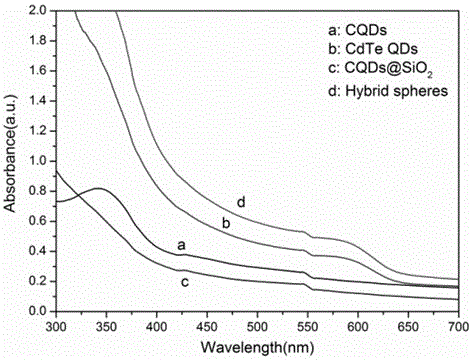A kind of divalent copper ion ratio fluorescent probe and its preparation method and application
A ratiometric fluorescent probe, divalent copper ion technology, used in fluorescence/phosphorescence, chemical instruments and methods, luminescent materials, etc., to achieve the effect of strong detection specificity, excellent detection limit, and no need for equipment
- Summary
- Abstract
- Description
- Claims
- Application Information
AI Technical Summary
Problems solved by technology
Method used
Image
Examples
Embodiment 1
[0036] 1) Synthesis of cadmium telluride quantum dots: under an inert gas atmosphere (argon), tellurium powder and NaBH 4 Stir in water, then add CdCl at pH 10 2 React with the mixed solution of TGA to control the Cd in the reaction product 2+ :TGA:Te 2- The molar ratio is 1:2.5:0.5;
[0037] 2) Synthesis of amino-modified carbon quantum dots: Centrifuge the citric acid aqueous solution with a concentration of 0.04g / ml after high temperature treatment, take the supernatant, and mix the supernatant with ammonium hydroxide at a volume ratio of 1:48 And carry out high-temperature treatment, add acetone after cooling down to room temperature, and then centrifuge, take the supernatant and place it in a vacuum drying oven to volatilize the acetone;
[0038] 3) Doped SiO 2 The synthesis of the blue fluorescent carbon quantum dot of nanoparticle: after step 2) gain is mixed with the chitosan solution of 0.5% (W / V), join in the mixed solution of cyclohexane, Triton X-100, n-hexanol...
Embodiment 2
[0041] 1) Synthesis of cadmium telluride quantum dots: under an inert gas atmosphere (argon), tellurium powder and NaBH 4 Stir in water, then add CdCl at pH 10 2 React with the mixed solution of TGA to control the Cd in the reaction product 2+ :TGA:Te 2- The molar ratio is 1:2.5:0.5;
[0042] 2) Synthesis of amino-modified carbon quantum dots: Centrifuge the citric acid aqueous solution with a concentration of 0.04g / ml after high temperature treatment, take the supernatant, and mix the supernatant with ammonium hydroxide at a volume ratio of 1:36 And carry out high-temperature treatment, add acetone after cooling down to room temperature, and then centrifuge, take the supernatant and place it in a vacuum drying oven to volatilize the acetone;
[0043] 3) Doped SiO 2 The synthesis of the blue fluorescent carbon quantum dot of nanoparticle: after step 2) gain is mixed with the chitosan solution of 0.5% (W / V), join in the mixed solution of cyclohexane, Triton X-100, n-hexanol...
Embodiment 3
[0046] 1) Synthesis of cadmium telluride quantum dots: under an inert gas atmosphere (argon), tellurium powder and NaBH 4 Stir in water, then add CdCl at pH 10 2 React with the mixed solution of TGA to control the Cd in the reaction product 2+ :TGA:Te 2- The molar ratio is 1:2.5:0.5;
[0047] 2) Synthesis of amino-modified carbon quantum dots: centrifuge the citric acid aqueous solution with a concentration of 0.04g / ml after high temperature treatment, take the supernatant, and mix the supernatant with ammonium hydroxide at a volume ratio of 1:50 And carry out high-temperature treatment, add acetone after cooling down to room temperature, and then centrifuge, take the supernatant and place it in a vacuum drying oven to volatilize the acetone;
[0048] 3) Doped SiO 2 The synthesis of the blue fluorescent carbon quantum dot of nanoparticle: after step 2) gain is mixed with the chitosan solution of 0.5% (W / V), join in the mixed solution of cyclohexane, Triton X-100, n-hexanol...
PUM
| Property | Measurement | Unit |
|---|---|---|
| particle diameter | aaaaa | aaaaa |
Abstract
Description
Claims
Application Information
 Login to View More
Login to View More - R&D
- Intellectual Property
- Life Sciences
- Materials
- Tech Scout
- Unparalleled Data Quality
- Higher Quality Content
- 60% Fewer Hallucinations
Browse by: Latest US Patents, China's latest patents, Technical Efficacy Thesaurus, Application Domain, Technology Topic, Popular Technical Reports.
© 2025 PatSnap. All rights reserved.Legal|Privacy policy|Modern Slavery Act Transparency Statement|Sitemap|About US| Contact US: help@patsnap.com



